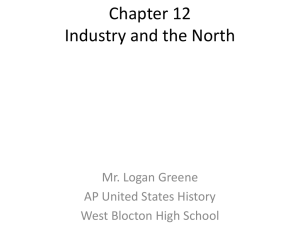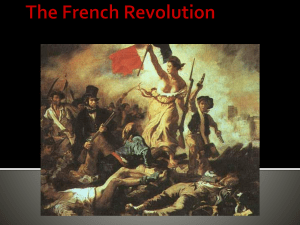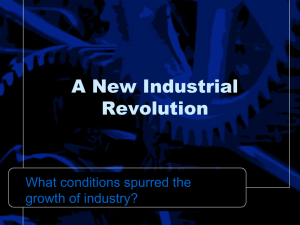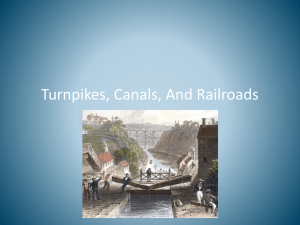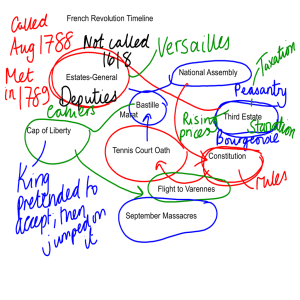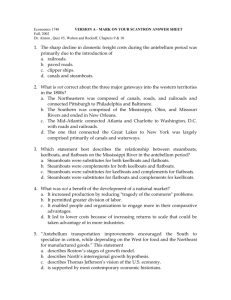Regular PowerPoint - Bremerton School District
advertisement
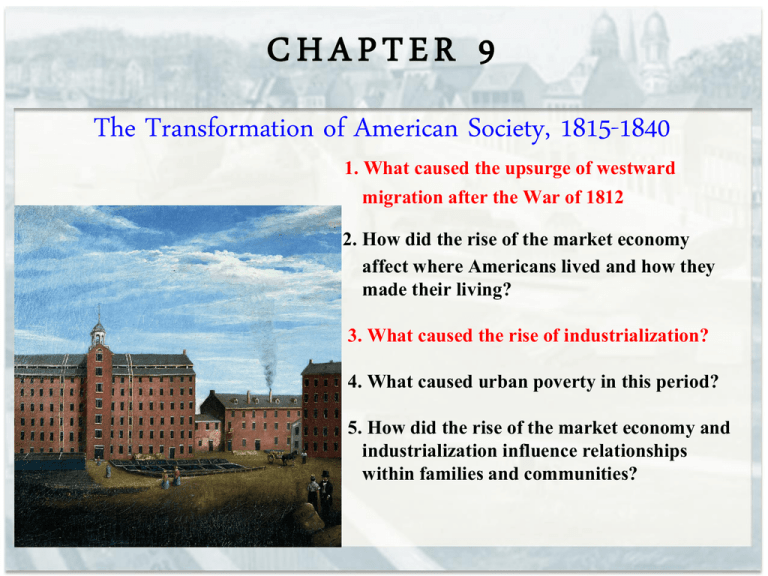
CHAPTER 9 The Transformation of American Society, 1815-1840 1. What caused the upsurge of westward migration after the War of 1812 2. How did the rise of the market economy affect where Americans lived and how they made their living? 3. What caused the rise of industrialization? 4. What caused urban poverty in this period? 5. How did the rise of the market economy and industrialization influence relationships within families and communities? Westward Expansion The Sweep West States added by 1821: • Vermont (1791) • Kentucky (1792) • Tennessee (1796) • Ohio (1803) • Louisiana (1812) • Indiana (1816) • Mississippi (1817) • Illinois (1818) • Alabama (1819) • Maine (1820) • Missouri (1821) ME VT NH NY CT PA IL IN MO OH KY TN VA NC SC MS AL GA LA RI NJ DE MD Westward Expansion Western Society and Customs Life was pretty crude and difficult out west, but they made the most of it… MEN: WOMEN: BOTH: Wrestling, feats of strength and agility, gander pulling Quilting/sewing parties, chicken pluckings Corn huskings, hoedowns and frolics Westward Expansion The Far West There was a little interest in the Far West at this time John Jacob Astor founded Astoria in 1811 as a fur trading post Mountain Men like Jedediah Smith explored the wild west Westward Expansion The Federal Government and the West The federal government stimulated interest and migration to the west… • Land Ordinance of 1785 • Northwest Ordinance of 1787 • Louisiana Purchase (1803) • Military land bounties (1812) • Support for the National Road (1816) • Removal of Indians (ongoing) Westward Expansion The Removal of the Indians In 1830, President Jackson (we’ll learn about him later) secured passage of the Indian Removal Act It went to the Supreme Court twice in Cherokee Nation v. Georgia and Worcester v. Georgia The Supreme Court said that the Cherokee had rights to the land Jackson said, “John Marshall has made his decision; now let him enforce it.” The Indians were forced off their land, many along the Trail of Tears Westward Expansion Working the Land: The Agricultural Boom After the War of 1812, there was a huge increase in demand for food and cotton, which caused the prices to increase, which caused interest in moving west Old Northwest = wheat and corn Old Southwest = cotton The Growth of the Market Economy Federal Land Policy The government policies on land sales… Year: Min. Acreage: Price per acre: Total Price: Time to pay it off: Price per year: 1796 640 acres $2 per acre $1280 1 year $1280 1800 320 acres $2 per acre $640 4 years $160 1832 40 acres $1.25 per acre $50 4 years $12.50 However… the land was mostly sold at public auctions and the rich bought huge tracts of land and then sold it to the poor farmers at a jacked up price. Once again, the rich get richer and the poor stay poor. The Growth of the Market Economy The Speculator and the Squatter The squatters somewhat regulated the progress of the land speculators Most squatters used up the good soil and then moved on The Growth of the Market Economy The Panic of 1819 Economic depressions used to be called panics was the land speculator, but the frontier farmers also suffered This caused many to hate and distrust banks… especially the Bank of the United States It also caused farmers to look for inexpensive ways to transport their goods Traversing the Land: The Transportation Revolution Steamboats, Canals, and Railroads 1807 - Robert Livingston and Robert Fulton invented the first successful steamboat and soon had a monopoly in New York and New Jersey. This cut travel time (especially up river) BIG TIME!!! In 1824, the Supreme Court (J. Marshall) ruled against the monopoly in the case of Gibbons v. Ogden which stated that the federal govt. has the power to regulate interstate commerce After that, the steamboat boom took off and competition created some extremely luxurious steamboats Traversing the Land: The Transportation Revolution Steamboats, Canals, and Railroads So now we had steamboats, but there were only so many rivers… so we built canals The canal boom was in the 1820s and 1830s. The biggest of these canals (Erie Canal) was finished in 1825 and connected the Midwest (Ohio) to the eastern coast. This canal made New York the biggest city in the U.S. Transportation costs went from $.30 per ton per mile to $.03 per ton per mile! Canals cost a lot to build, so many state governments used state money to get them built The boom was short lived as the railroad boom soon followed Traversing the Land: The Transportation Revolution Steamboats, Canals, and Railroads Railroads “replaced” canals as they were cheaper to build, faster, and could reach more places The boom started in America in the 1840s, but started slowly as they were financed by private corporations rather than the govt. and therefore were often times under repair Traversing the Land: The Transportation Revolution The Growth of the Cities The transportation revolution from 1820-1860 caused the most rapid urbanization in U.S. history First it was cities along rivers (Pittsburgh, Cincinnati, Louisville, Saint Louis, New Orleans) Then it was the cities along lakes and canals (Buffalo, Cleveland, Detroit, Chicago, Milwaukee) Industrial Beginnings Causes of Industrialization • Embargo of 1807 (from trade to manufacturing) • Protective tariffs (buy American – it’s cheaper) • Abundant water power for mills (from many mountain streams) • Improvements in transportation (reduced shipping costs) • New technology (saved time = saved money) Industrial Beginnings Textile Towns in New England Waltham and Lowell mills in MA differed from the earlier Slater mills in RI. Slater’s had unfinished fabrics and hired families. W&L mills, however… • Created a finished product • 80% of labor force = unmarried women (cheaper) • Had to live “on campus” • Mandatory church attendance • 10 P.M. curfew • “moral” police The mills were extremely humid with the windows nailed shut, very loud, and exceptionally dusty. The work was tedious, hard and pay was average. Industrial Beginnings Artisans and Workers in Mid-Atlantic Cities Low-paid and unskilled (or semi-skilled) workers began replacing the skilled artisans The skilled artisans then formed trade unions to help protect their craft Equality and Inequality Urban Inequality: The Rich and the Poor The gap between the rich and poor grew even more during 1815-1840 “Rags to riches” was mostly a myth Usually money was inherited, married into, and reinvested The poor were classified as paupers or deserving poor or as the undeserving poor (drunkards and loafers) The Five Points area of NYC was perhaps the worst area in the U.S. and included many Irish immigrants who were hated for many reasons such as being poor, drunks, and Catholic Equality and Inequality Free Blacks in the North Blacks were free, but heavily discriminated against… • No suffrage • Segregated schools (or no schools) • Separate facilities • Only got the cruddy jobs Richard Allen started the first AME church in 1816 in Philadelphia. Black churches ran schools, held antislavery activities, and ran self-help programs Equality and Inequality The “Middling” Classes Most Americans weren’t rich or poor… they were in the middle. The middling class back then was unpredictable and the people tended to move a lot. The Revolution in Social Relationships The Attack on the Professions Economic changes sometimes led to the questioning of authority, especially with professions such as lawyers, doctors, and ministers The Revolution in Social Relationships The Challenge to Family Authority As the middle class questioned professionals… so did children question their parents Sons and daughters both moved away from the family earlier and more often Young folks started marrying for love, marrying out of birth order, and some remaining single! The Revolution in Social Relationships Wives and Husbands Doctrine of Separate Spheres MEN WOMEN • Moral Influences • Making money • Raising children • Governing stuff • Making the house a “home” • Politics Vaginal Douching Birth Control Families wanted to have fewer children, so they practiced various forms of birth control such as Coitus Interruptus The Revolution in Social Relationships Horizontal Allegiances and the Rise of Voluntary Associations Vertical allegiances were replaced by horizontal allegiances Many folks joined voluntary associations… • Temperance Societies • Moral Reform groups • Debate clubs • Workers Unions • Racial groups


